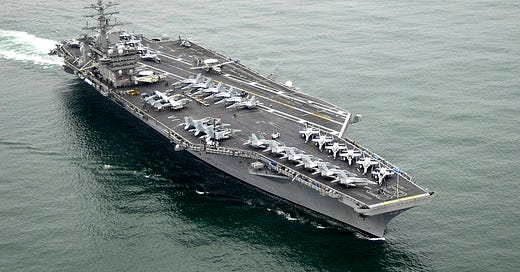This week I had a conversation with my friend Rob who runs the Seeds Innovation Lab. We were talking about the difficulty which many organizations have in implementing change and he described organizational inertia in a very simple way. I think it is fair to say that ministries and churches suffer from this far more than businesses do, often because of how ministry funding works and the nature of delayed consequences.
Rob was once a sailor on the USS Nimitz, a US aircraft carrier that is also the namesake for an entire class of aircraft carriers, the Nimitz Class. The Nimitz was built for $8.5 billion and was capable of cruising at just over 30 knots, which is 35 MPH. Now, that might not sound impressive to you, but it is. I sail Hobie Cats and they are small, fast little boats. But I have never gotten my Hobie Cat much over 20 knots, let alone 30 (the actual speed is classified, so it probably goes faster)! That is cooking for a ship of this size. In fact, the Nimitz is the heaviest warship in the world. The weight of these large ships is described in terms of displacement. The Nimitz displaces 104,000 tons. Did I mention that the propulsion system is nuclear? They can run for 20 years without refueling, but when it is time to fill ‘er up, it takes about 3 years.
The Nimitz can stop in about two ship lengths by counter-rotating the propellers. But imagine if the ship was just “turned off.” There was no counter-rotation and the ship just moved until it stopped. This would take a long time, covering quite a bit of distance. The entire time, the boat would move forward under “old energy.” It is a bit like a train wreck, in which the engine stops pulling the train, but the “old energy” keeps moving that train along, pushing each successive car forward in a spectacular crashing disaster.
“Old energy” is also what keeps a lot of ministries going well past their ability to generate “new energy.” This is true in terms of ideas, people, funding, and so many other facets of a ministry. What compounds this problem is that ministries (including churches) spiritualize their methodologies, making them immune to critique.
Old energy represents itself in ministry in several ways. It might be a commitment to an old paradigm that once worked well (this is the conversation about evangelism that has been going on in Evangelicalism). It might be that the effects of the energy “shut off” is delayed (this might be happening with missionary recruitment in an environment where churches are losing people). Or, it could be that funding keeps coming in, despite the irrelevancy of the mission and the goals of the ministry (this happens when older donors give based on the past relationship or success of the now-failing ministry). There are many ways this happens.
Lean organizational principles can help avoid organizational inertia. What that means is past the scope of this article, but I can give you one example. Some years ago, I pitched a Board of Directors on the idea that we needed an endowment fund to cover operational costs. One of the board members, a CEO of one of the largest corporations on Wall Street, chuckled and said, “No, we don’t want any trust fund babies leading this organization.” What he meant was that an endowment would make our leadership team less hungry. We would rely on the money instead of working hard and, through faith and risk-taking, seeing results because of good decision-making. Endowments create comfort and sustain the status quo.
Where is your ministry at right now? Are you steaming along under nuclear power or is it being fueled by “old energy” from your history?




